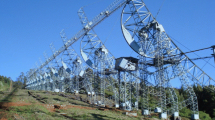Abstract
A description is given of theFreja double-probe electric field instrument. Its capability to perform high-resolution measurements of the aurora and its fine-structure as well as collect information on sub-auroral and low-latitude phenomena is illustrated by selected results from the first six months of operation. The instrument is highly flexible and possible to operate in a number of different modes. It is also equipped with a 4-Megabyte burst memory for high data sampling rate and temporary storage of data. It has been fully operational since October 1992, and delivers data from ≈22 hr day−1 including about 5–6 auroral crossings of the northern and southern auroral ionosphere. New and important information on the auroral fine structure and electrodynamics is obtained by means of burst resolution data (6144 samples s−1) and normal resolution data (768 samples s−1). Common burst data collection triggered by the electric field event detector has turned out to be very useful for the selection of scientifically interesting events. This is illustrated by high-resolution data of a pair of extremely intense and narrow electric field structures (1 V m−1) which are associated with a total absence of precipitating particles, depletions of the thermal plasma and with an intense wave activity. The low inclination of theFreja orbit provides a new perspective for studying largescale phenomena associated with east-west gradients as is exemplified by electric field data from a satellite crossing over north-south oriented auroral structures presumably resulting from rotational distortions of east-west aligned auroral arcs. The different plasma regimes encountered byFreja are continuously monitored by means of current sweeps applied to the probes and by the satellite potential. In addition, overview data (8 samples s−1) are collected from full orbits and stored in the on-board memory and have proved to be extremely valuable, providing new information on global electric field phenomena at subauroral and lower latitudes, such as the intense poleward electric fields and Pc-1 observations that have been made near the plasmapause during substorm activity.
Similar content being viewed by others
References
Aggson, T. L., Maynard, N. C., Hanson, W. B., and Saba, J. L.: 1992, ‘Electric Field Observations of Equatorial Bubbles’,J. Geophys. Res. 97, 2997.
Anderson, P. C., Hanson, W. B., and Heelis, R. A.: 1991, ‘The Ionospheric Signatures of Rapid Sub-Auroral Ion Drifts’,J. Geophys. Res. 96, 5785.
André, M. and Eliasson, L.: 1992, ‘Electron Acceleration by Low-Frequency Electric Field Fluctuations: Electron Conics’,Geophys. Res. Letters 19, 1073.
Blomberg, L. G. and Marklund, G. T.: 1993, ‘High-Latitude Electrodynamics and Aurorae During Northward IMF’,Auroral Plasma Dynamics, AGU Monograph,80, 55.
Boström, R., Gustafsson, G., Holback, B., Holmgren, G., Koskinen, H., and Kintner, P.: 1988, ‘Characteristics of Solitary Waves and Weak Double Layers in the Magnetospheric Plasma’,Phys. Rev. Letters 61, 82.
Hultqvist, B.: 1988, ‘On the Acceleration of Electrons and Positive Ions in the Same Direction along Magnetic Field Lines by Parallel Electric Fields’,J. Geophys. Res. 93, 9777.
Hultqvist, B., Vo, H., Lundin, R., Aparicio, B., Lindqvist, P.-A., Gustafsson, G. and Holback, B.: 1991, ‘On the Upward Acceleration of Electrons and Ions by Low-Frequency Electric Field Fluctuations Observed by Viking’,J. Geophys. Res. 96, 11609.
Lindqvist, P.-A. and Marklund, G. T.: 1990, ‘A Statistical Study of High-Altitude Electric Fields Measured on the Viking Satellite’,J. Geophys. Res. 95, 5867.
Lundin, R., Gustafsson, G., Eriksson, A. I. and Marklund, G. T.: 1990, ‘On the Importance of High-Altitude Low-Frequency Electric Field Fluctuations for the Escape of Ionospheric Ions’,J. Geophys. Res. 95, 5905.
Mälkki, A., Eriksson, A. I., Dovner, P.-O., Boström, R., Holback, B., Holmgren, G., and Koskinen, H. E. J.: 1993, ‘A Statistical Survey of Auroral Solitary Waves and Weak Double Layers: 1. Occurrence and Net Voltage’,J. Geophys. Res. 98, 15521.
Marklund, G. T.: 1993, ‘Viking Investigations of Auroral Electrodynamical Processes’,J. Geophys. Res. 98, 1691.
Marklund, G. T. and Blomberg, L. G.: 1991, ‘Toward a Better Understanding of the Global Auroral Electrodynamics through Numerical Modeling Studies’,Magnetospheric Substorms, AGU Monograph 64, 305.
Sugiura, M., Maynard, N. C., Farthing, W. H., Heppner, J. P., and Ledley, B. G.: 1982, ‘Initial Results on the Correlation between the Magnetic and Electric Fields Observed from the DE-2 Satellite in the Field-Aligned Current Regions’,Geophys. Res. Letters 9, 985.
Temerin, M., Cerny, K., Lotko, W., and Mozer, F. S.: 1982, ‘Observations of Double Layers and Solitary Waves in Auroral Plasma’,Phys. Rev. Letters 48, 1175.
Weimer, D. R., Goertz, C. K., Gurnett, D. A., Maynard, N. C., and Burch, J. L.: 1985, ‘Auroral Zone Electric Fields from DE 1 and 2 at Magnetic Conjunctions’,J. Geophys. Res. 90, 7479.
Author information
Authors and Affiliations
Rights and permissions
About this article
Cite this article
Marklund, G.T., Blomberg, L.G., Lindqvist, P.A. et al. The double probe electric field experiment on Freja: Experiment description and first results. Space Sci Rev 70, 483–508 (1994). https://doi.org/10.1007/BF00756883
Received:
Issue Date:
DOI: https://doi.org/10.1007/BF00756883




